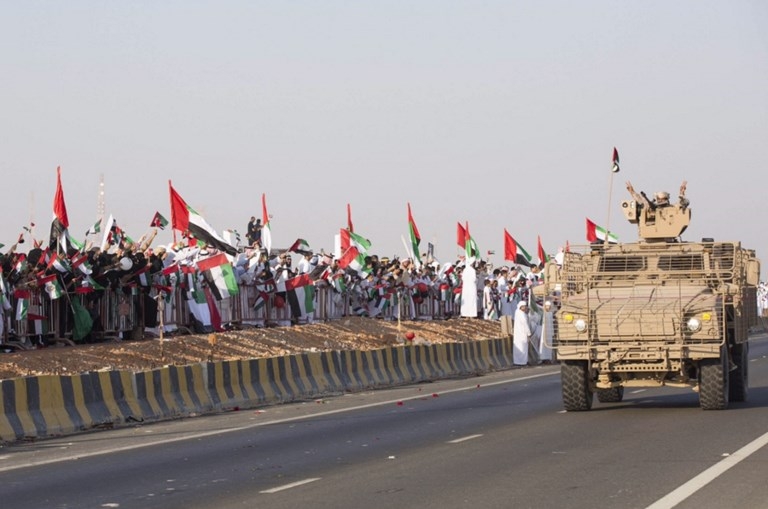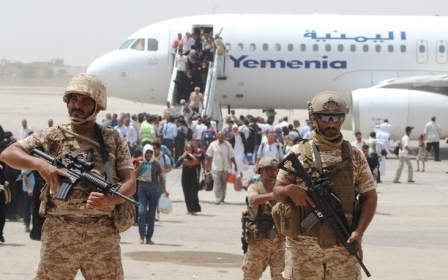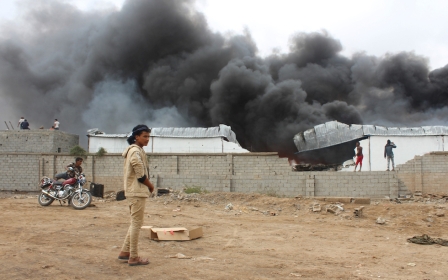Abu Dhabi’s quest for an eighth emirate in Yemen

The recent capture by southern Yemeni separatists of the port city of Aden was just the latest twist in a brutal war that has killed more than 10,000 people since the start of a Saudi-led coalition’s relentless bombing campaign on Houthi rebels in March 2015.
As the war grinds on, the United Arab Emirates has been increasingly breaking ranks with the Saudi coalition to pursue its own agenda.
Network of torture prisons
While Riyadh has been reluctant to send ground forces to Yemen, the UAE has had large-scale ground troops there for quite some time. The Emiratis played a key role in recapturing the port city of Aden from the Houthis in July 2015, and have played a leading role in the fight against al-Qaeda in southern Yemen for more than two years. Abu Dhabi is responsible for training tens of thousands of Yemeni troops in the south and importing hundreds of highly skilled mercenaries from South America to fight on its behalf.
The UAE is operating a network of torture prisons in southern Yemen, where thousands of terror suspects are “disappearing” and where, in the strict division of labour, the “UAE tortures and US interrogates”. The UAE has well and truly established a parallel security structure in southern Yemen, whose local troops solely answer to Abu Dhabi.
The most recent events illustrate once again that the UAE and Saudi Arabia are standing on hostile sides in this complex, multi-layered war
The UAE’s Yemen presence should be viewed from a meta-perspective. By controlling strategically important trade hubs, the Emiratis are pursuing the establishment of trans-regional structures in the Middle East and beyond in order to further expand their fossil-fuel trade to Europe and North America. To that end, Abu Dhabi is forcing its way into the region's energy and security infrastructure at a rapid pace: from Eritrea and Somaliland to Cyprus and Libya's Benghazi.
In Yemen, these ambitions have manifested in several strategically important ways: the recapture of Perim island in the Bab-el-Mandeb Strait, the transformation of the island of Socotra in the Gulf of Aden into the UAE’s very own tourism and military colony, and successful efforts to gain control over a network of ports in Yemen.
Emiratis as occupiers
Emirati troops, however, are mostly regarded as occupiers. President Abd Rabbuh Mansour Hadi has accused them of behaving more like an occupying power than a force of liberation.
Since the beginning of the war, the call for a division into North and South Yemen has been getting louder; however, all major parties to the conflict, at least officially, have stressed their commitment to the territorial integrity of Yemen. But for over a year now, secessionist forces have been gaining momentum domestically, with strong support from the UAE.
The UAE is ambitiously pursuing the project of a divided Yemen. The rift became apparent in all its absurdity when the Emiratis denied Hadi entry to Aden, his hometown - a memorable symbol of the balance of power in the country.
After investing billions in infrastructure and arming separatist militias in southern Yemen, the UAE is now harvesting its secessionist crops. The Emiratis have in mind a vassal province – a kind of eighth emirate of South Yemen – which, with its strategically important geography and provision of energy infrastructure, could enable the rise of the UAE as a global energy superpower.
The fall of Aden
Abu Dhabi's key tool to achieve that goal has been the Southern Transitional Council (STC) formed in May 2017. After Hadi ignored the STC’s ultimatum for the dismissal of Prime Minister Ahmed bin Daghr, whom it accused of “rampant corruption”, fierce fighting erupted in Aden last month, killing more than 36 people and wounding hundreds more. The STC ultimately took control of the de facto capital, Aden.
Flags of the former South Yemen were raised at the entrance gate of the presidential palace. Daghr spoke of a “coup” while a high-ranking STC official announced that the “uprising” would continue until the Hadi government was “toppled”.
The STC is backed by the UAE through arms deliveries, financial support and military advice. The council’s leader, the former governor of Aden, Aidarus al-Zoubaidi, is known to have been under the UAE’s patronage for years.
The strategic military component of this collaboration manifested in the conquest of the military base of Hadi's presidential guard in January. Only after Emirati fighter jets bombarded the base and weakened troops loyal to Hadi was the facility able to be seized by STC forces on the ground. The UAE acts as the STC’s air force.
Relentless pursuit of energy goals
The most recent events illustrate once again that the UAE and Saudi Arabia are standing on hostile sides in this complex, multi-layered war. While the Saudis stand firmly by Hadi's side, a senior Emirati security official openly calls for his overthrow.
In August 2017, emails from two former high-ranking US officials leaked to Middle East Eye showed that Saudi Crown Prince Mohammed bin Salman “wants out” of the costly war in Yemen, which he had started more than two years earlier. Apparently realising that Hadi’s reinstatement is an unreachable goal, Riyadh has shifted its attention to the very limited task of securing its southern border against the Houthis.
Abu Dhabi, in turn, is not really interested in the Houthis. From the outset, the fight against them was the pretext to set a military foot in southern Yemen.
The UAE’s sole interest is controlling the 2,000 kilometres of Yemeni coast – a central pillar of Abu Dhabi's plans to become a global energy superpower, which it is relentlessly pursuing instead of negotiating the legitimate co-use of Yemeni ports and investments in the country’s energy infrastructure.
Jakob Reimann is the head and editor of the German-based website JusticeNow!. He is soon to publish a book on the future of NATO and is writing another one on empires in the 21st century.
The views expressed in this article belong to the author and do not necessarily reflect the editorial policy of Middle East Eye.
Photo: Emiratis welcome a UAE military convoy returning from Yemen (AFP PHOTO/HO/WAM)
This article is available in French on Middle East Eye French edition.
New MEE newsletter: Jerusalem Dispatch
Sign up to get the latest insights and analysis on Israel-Palestine, alongside Turkey Unpacked and other MEE newsletters
Middle East Eye delivers independent and unrivalled coverage and analysis of the Middle East, North Africa and beyond. To learn more about republishing this content and the associated fees, please fill out this form. More about MEE can be found here.






